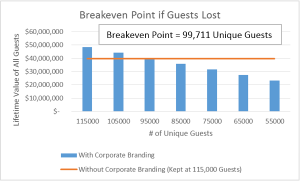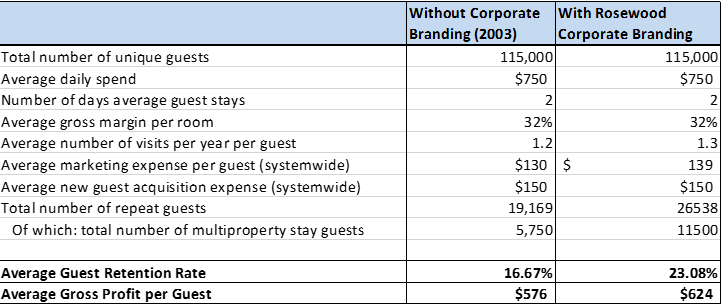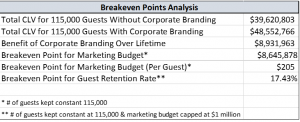Customer Lifetime Value Analysis
This past semester one of the most valuable tools that I was exposed to was that of Customer Lifetime Value (CLV). I was familiar with the concept; however, in my previous job the numbers were always given to me and it was not my responsibility to calculate them. Seeing first-hand what goes into a quality CLV analysis was eye-opening and something that I found incredibly interesting. I have a strong fondness for Excel and analysis so being able to utilize Excel to explore and analyze key marketing concepts is something that really peaks my interest.
Below is a brief excerpt from my analysis on Rosewood Hotels as they were deciding whether or not to switch from a House of Brands model where each resort has a unique identity and Rosewood is kept secondary to a Branded House model or corporate branding strategy where the brand of Rosewood is kept at the forefront for each hotel.
Rosewood CLV
By switching to a corporate branding strategy the average number of visits per year, per guest is expected to increase by 8% resulting in an increase in average guest retention rate of 6.4%. The increase in number of visits per year also results in an increase of $48 gross profit per guest. Even with the $1,000,000 investment required for marketing, the CLV per guest is expected to increase $77 with the corporate branding strategy. Assuming that the number of unique guests is 115,000 with either branding strategy the resulting increase in overall customer CLV is $8.9 million. It is recommended that the corporate branding strategy be pursued; however, there are potential risks.
guest is expected to increase by 8% resulting in an increase in average guest retention rate of 6.4%. The increase in number of visits per year also results in an increase of $48 gross profit per guest. Even with the $1,000,000 investment required for marketing, the CLV per guest is expected to increase $77 with the corporate branding strategy. Assuming that the number of unique guests is 115,000 with either branding strategy the resulting increase in overall customer CLV is $8.9 million. It is recommended that the corporate branding strategy be pursued; however, there are potential risks.
Potential Risks
One potential risk of changing the branding strategy is that some previously loyal guests may defect to the competition. Assuming 115,000 unique guests with our current branding strategy, it would take 15,000 guests to defect (a retention rate of 17.43%) in order for the overall CLV to be equal in both strategies (appendix D). It is unlikely that the change in branding strategy will result in the loss of 15,000+ guests so this risk is small and can be mitigated further through proper marketing and customer service.
Another potential risk is that the marketing budget will be more than expected. The breakeven point for the marketing budget where the overall CLV for both strategies is the same is $8.65 million or $205/guest (appendix D). This is almost 8 times more than what is expected so there is a lot of wiggle room in the marketing budget.
Other potential risks of switching to a corporate branding strategy are losing our main point of differentiation which is providing unique, one-of-a-kind properties for our customers, and upsetting those who are strongly associated with our current individual hotel brands
Conclusion
The analysis shows that the corporate branding strategy will increase CLV and that the increase in CLV will cover the marketing costs associated with the change in branding strategy. While the numbers look great, it is important be aware of and plan for the service offerings and the overall culture shift that is necessary to successfully change to a corporate branding strategy without losing the overall brand identity and points of differentiation.




 Follow
Follow